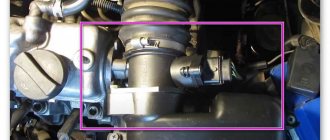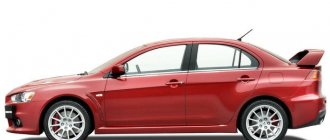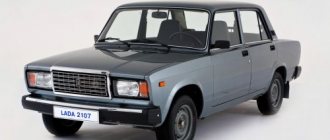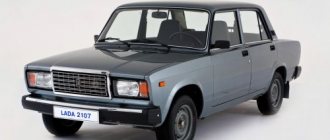Options for solving the problem of Lada Priora with increased idle consumption
You should not base your car’s fuel consumption on the basis of the indicators provided by the on-board computer. As is known, such technologies, especially considering that they were produced in Russia, have low accuracy. To check the actual consumption, you need to use the often practiced “from refueling to refueling” method:
- first, the fuel tank is completely filled;
- the flow meter counter is set to zero;
- driving is carried out until a signal lights up on the dashboard, indicating that the fuel level is close to zero;
- then the car is refueled again to a full tank.
As a result, you need to look at the refueling machine's meter to see how much gasoline was actually filled, then compare this data with what is displayed on the meter, and make basic calculations that will show the real consumption.
If concerns about increased consumption are confirmed, you will have to worry about replacing some components. Which ones exactly cannot be determined at random, therefore preliminary computer diagnostics and visual assessment will be required.
There is a high probability that reflashing the engine will help normalize consumption. The latest programs can reduce its value at idle to the optimal 0.5-1 liters per 100 kilometers.
However, the problem may remain unresolved even after taking all the indicated measures - cases of factory defects in Lada Priora cars, regardless of the year of manufacture, are very common. In this case, there is nothing else to do but contact representatives of the official dealer in your region.
And, finally, the best recommendation that can be given to the owner of a Priora is to seriously think about buying a car of another brand, which has much higher reliability and efficiency indicators at a comparable cost of the car itself and its service.
For your information
- When estimating the actual amount of fuel consumption, it is advisable to follow the generally accepted method: fill the tank full, reset the odometer, drive a certain number of km and fill the tank full again, while simultaneously noting the amount of liquid filled. The required value is found by dividing liters by kilometers traveled.
- The on-board computer in mixed mode, after resetting, starts counting from 19.9 l/100 km.
- To visually assess consumption, you should “monitor” the current indicator in 4th and 5th gears during quiet driving.
Lada Priora (2020). increased fuel consumption
| List of possible faults | Diagnostics | Elimination methods |
| The air filter element is clogged | Check the condition of the air filter replacement element | Blow or replace the air filter element |
| Leaking power system | Smell of gasoline, fuel leaks | Check the tightness of the connections of the fuel system elements; If a malfunction is detected, replace the corresponding components |
| Spark plugs are faulty: current leakage through cracks in the insulator or carbon deposits on the heat cone, poor contact of the central electrode | Spark plugs are checked on a special stand at a service station. The absence of external damage and sparking between the electrodes on the inverted spark plug does not allow us to draw a conclusion about its functionality | Replace spark plugs |
| Throttle actuator malfunction | Check the travel of the gas pedal, the clearance in the drive (free play of the pedal), make sure that the cable and pedal are not jammed | Replace faulty parts, lubricate the cable with engine oil |
| The idle speed controller or its circuits are faulty | Replace the regulator with a known good one. | Replace the faulty regulator |
| The throttle valve does not close completely | The gap between the throttle valve and the walls of the housing is visible in the light | Replace the throttle assembly |
| Increased pressure in the fuel line due to a faulty pressure regulator | Check the pressure in the fuel system with a pressure gauge (no more than 3.5 bar) | Replace the faulty regulator |
| Leaking injectors | Check the injectors | Replace faulty injectors |
| The coolant temperature sensor or its circuit is faulty | Check the sensor resistance with an ohmmeter at different temperatures | Restore contact in electrical circuits, replace the faulty sensor |
| The oxygen concentration sensor is faulty | You can evaluate the performance of the oxygen concentration sensor and the reliability of its electrical circuit connections using diagnostic equipment at a service station | Restore damaged electrical circuits, replace faulty sensor |
| The ECU or its circuits are faulty | To check, replace the ECU with a known good one. | Replace the faulty ECU, restore damaged electrical circuits |
| Low compression in the engine cylinders (less than 11.0 bar): clearances in the drive are not adjusted, wear or damage to the valves, their guides and seats, stuck or broken piston rings | Check compression | Adjust the clearances in the valve drive. Replace faulty parts |
| The throttle position sensor, absolute pressure and air temperature sensors in the intake manifold or their circuits are faulty | Check the sensors and their circuits | Restore contact in the electrical circuits, replace the faulty sensor(s) |
| Increased resistance to gas movement in the exhaust system | Inspect the exhaust system for dented or damaged pipes, check the condition of the catalytic converter | Replace damaged exhaust system components |
| Malfunctions of the chassis and brake system | Check the chassis and brake system | Adjust the wheel alignment angles, replace faulty chassis parts, and troubleshoot the brake system. |
What are the reasons for the high fuel consumption of the VAZ-2109 carburetor
Technical reasons for increased fuel consumption
Despite the fact that VAZ has stepped far forward in improving its products, many unresolved problems remain. And some of them have a direct impact on the amount of gasoline consumed.
Injector diagram (fuel supply to combustion chambers)
All influencing factors can be divided into “hardware” and “software”. This classification was the result of the use of an injection engine, as well as the abundance of sensors in the car’s design.
Incorrectly selected fuel
It is recommended to fill AvtoVAZ engines with 95-grade gasoline only. Only then will the engine control system begin to correctly calculate the parameters for preparing the fuel mixture. Therefore, when using gasoline with an octane number below 95, fuel consumption will increase and foreign vibrations may appear in its operation.
Electronic system errors
They can be considered one of the simplest situations, since they can be corrected by simply contacting a specialized service center. Problems of this kind arise for the simple reason that some sensors that are used to prepare the working mixture begin to function incorrectly.
Diagnosis of car electronic systems
In particular, we are talking about
- temperature sensors,
- throttle position sensors,
- as well as mass air flow.
In the latter case, its breakdown may be due to the fact that the air filter has not been changed for a long time. And, of course, incorrect readings can result from false information from the oxygen sensor, which is also simply called a lambda probe.
All this can lead to both the preparation of a “lean” and “rich” mixture. As a result, power may be lost or fuel consumption may increase. A malfunction can be detected by diagnosing each sensor separately.
Fuel system pressure
In Fig. car fuel frame and receiver
This is another common breakdown. The fact is that the pressure level can be too high or low, although the second option is much more common. This can be determined when the engine loses power and you have to drive at higher speeds to maintain the desired dynamics. This all significantly increases fuel consumption.
If you have problems with the fuel rail, the car may not start.
Injector problem
If you do not monitor the condition of the power unit, this will lead to shortcomings in its operation. Most often, this concerns contamination of the injectors, which is followed by poor supply of the working mixture, so that the engine begins to “triple”, and you try to compensate for this by increasing the speed.
Catalyst destruction
Similar results occur when the catalyst burns out or even breaks down. Without going into detail about the specifics of this situation, we can simply conclude that if the catalyst is contaminated, a “rich” mixture will form. After this, additional heating of the catalyst occurs, reducing its service life and reducing engine power. Fuel consumption will be maximum.
Motor temperature
In addition to all of the above, it would be a good idea to constantly monitor the engine temperature. If it is above 103 degrees, then the mixture will not be of sufficient quality. The engine will begin to operate on a “lean” mixture, reducing its power and increasing gasoline consumption.
The main drawback is that the instrument panel on the Lada Granta does not have a real-time indication of the engine temperature, read how this can be fixed here.
If the engine has not yet warmed up, this leads to an increase in consumption due to the “enrichment” of the mixture. The level of overspending reaches 20 percent. In most cases, the cause must be found in the thermostat.
Incorrect engine operation
Increased fuel consumption may be due to a “broken” engine. That is, the engine is worn out. The main symptoms of engine wear will be:
- There is no compression.
- Maslozhor.
- Other.
- bad dynamics
- erratic engine operation
Air filter dirty
And, of course, we must not forget that if air flows poorly through this filter, the effect of “oxygen starvation” will begin. This will entail a significant excess of gasoline consumption.
How to reduce consumption using “economical firmware”?
The only advice would be not to perform these procedures if you have a valid car warranty. In addition, only professionals should do this. If you do this yourself, then you need to first study this topic in detail.
pros
Fuel consumption calculator: calculate fuel consumption
"Lada Priora", without a doubt, captivated many with its characteristics and price. However, its engine has a number of pros and cons, knowing which you can avoid many problems. Among the advantages are the following:
- Reliability. Yes, the Lada engine is far from the BMW, but it copes with the assigned tasks with a bang. Simple and good-quality, it can last up to 200 thousand kilometers, and after major repairs it can last the same amount.
- Cheap consumables. Engine parts can hardly be called cheap by definition, but repairs from Priora will cost much less than cars from foreign manufacturers.
- The power for a lightweight Lada 2170 is quite sufficient to accelerate at a sufficient speed. The 21126 engine with 16 valves can produce power up to 100 horsepower and reach speeds of up to 180 km/h.
- Environmentally friendly. The Priora engine fully complies with European quality standards and emits less exhaust gases into the atmosphere than its predecessors.
- Good traction at both high and low speeds appeared after modification of the exhaust manifold.
- The efficiency of the 16-valve engine is significantly greater than that of previous generations of Lada due to its design. Because of this, the car consumes less fuel.
As you can see, there are many advantages. It is not difficult to understand why the Lada Priora became so popular in Russia. The Russian-made car was created for our roads, and its design took into account all the pitfalls. But not a single thing can be ideal, so disadvantages can also be found in the VAZ-2170.
Lada Priora (2013+). Vibrations when accelerating and decelerating
| Possible causes of malfunction | Troubleshooting |
| Worn inner joint | Replace the hinge or drive assembly |
| The intermediate shaft is deformed | Replace the drive assembly |
| Worn intermediate bearing | Remove the intermediate support bracket and check the play in the bearing. Replace the faulty bearing |
Kia rio: fuel consumption per 100 km
Lada Priora (2013+).
Battery faults
The battery is discharged. The starter does not turn the engine crankshaft or turns it slowly, the lamps are dim.
Cause of malfunction Methods of elimination The car has not been used for a long time. Charge the battery using a charger or in another car. The belt tension is loose. Tighten the alternator drive belt. When the engine is turned off, many electrical consumers are running (the head unit of the sound reproduction system, etc.) Reduce the number of consumers operating from the battery Damage to the insulation of electrical circuits, current leakage on the surface of the battery Check the leakage current (no more than 11 mA when consumers are disconnected), clean battery surface
Beware of acid! The generator is faulty See diagnostics of generator faults Short circuit between the plates (“boiling” of the electrolyte, local heating of the battery) Replace the battery
Lada Priora (2013+).
The low battery indicator light is on
| The battery low charge indicator is on. The vehicle's on-board voltage is below 15 V. | |
| Cause of malfunction | Elimination methods |
| The generator drive belt tension is loose | Tighten your belt |
| The voltage regulator is faulty. | Replace regulator |
| The diodes of the rectifier unit are damaged | Replace the rectifier unit |
| The connection of the excitation winding terminals with the slip rings is broken, there is a short circuit or a break in the winding | Solder the leads, replace the generator rotor or generator assembly |
| Open circuit or short circuit in the stator winding, shorting it to ground (when shorted, the generator howls) | Check the winding with an ohmmeter. Replace the stator or generator assembly |
Lada Priora (2013+).
The vehicle's on-board voltage is higher than 15.1
| The vehicle's on-board voltage is higher than 15.1 V | |
| Cause of malfunction | Elimination methods |
| Damaged voltage regulator | Replace voltage regulator |
Video on the topic “Lada Priora (2013+). INCREASED FUEL CONSUMPTION"
What affects consumption or why the car consumes gasoline. From the experience of my TAZ Kalina
VAZ is the result of cleaning the mass air flow sensor and throttle body using spark plugs
We measure the consumption on Priora part 3
Reasons for increased fuel consumption of Lada Vesta
The cost of gasoline consumption today is taking a significant toll on your wallet. It’s rare that a Vesta owner won’t notice that gas mileage has increased. High fuel consumption often indicates a car malfunction, but this is not always the case. Let's look at the reasons for the increase in gasoline consumption following the example of the Lada Vesta Cross SV.
On the mechanics, everything depends on the driver’s experience, but even incorrect gear shifting will increase the car’s fuel consumption. The engine speed has increased, the gearbox continues to transmit torque in the previous gear, no shifting occurs, and naturally more energy and gasoline are consumed, respectively. With the right gear, at the right speed, the car would have already gone further, so the fuel is wasted.
The robot automatically changes gears; it turns out that 100 km for a manual transmission is more expensive than for a manual transmission. With a robotic gearbox, the station wagon can more easily withstand sudden accelerations and braking, which characterize city trips. On the highway there are always high gears and high speed and consumption is 1.5-2 liters lower. But the route is different - ups and downs, serpentines and a flat road. A long uphill climb puts more stress on the engine, which increases the amount of gasoline used.
Switched on energy consumers take charge from the engine and affect the amount of gasoline burned. Moreover, this applies not only to the air conditioner or subwoofer, but also to ordinary car headlights.
In winter, fuel combustion increases due to the constant inclusion of additional equipment, due to the engine warming up before driving.
Uneven tire pressure increases the load on the internal combustion engine. Tires that are too narrow or too wide can also affect fuel consumption.
During the cold season
In winter, any car more often requires filling the tank. Fuel is spent on heating the interior, braking, turning and other elements of driving, which turn into stunts when there is a lot of snow on the street, the number of accidents increases, they appear out of nowhere, and traffic jams suddenly disappear. Lada Priora moves confidently in any weather, because it has a very convenient body shape and dimensions. This is what will help reduce fuel consumption.
Driving around the city requires a special driving style. Having developed it, each driver will take care of the budget and expenses. It should be remembered that a sudden change of direction, braking and speeding up is not only a risk, but also a waste of fuel. If you find yourself in a traffic jam, it is better to turn off the engine. More effective ways to increase the savings rate in winter have not yet been invented. But by following these recommendations, you can achieve a lot. Worth a try.
Lada Priora details about fuel consumption
Nowadays, the issue of fuel consumption has become as relevant as ever, because gasoline prices are rising every day. Car owners always try to choose a more economical model, and Lada Priora is one of them. The fuel consumption of the Priora will please motorists, because it turned out to be pleasantly profitable. It may depend directly on the configuration of the car, but since, basically, they all have sixteen valves, the consumption of a 16-valve Priora per 100 km is not particularly different from other models.
Initial characteristics
Car manufacturers always indicate the technical characteristics of their products with some errors. And Priora, produced by the automobile company AvtoVAZ, is perhaps no exception. Initial data for this car included gasoline consumption of 6.8 to 7.3 liters/100 km. But the real data of this model fluctuate a little and not even in the smallest amounts. And the consumption rates for such a Lada per 100 km are already different. Now we will try to show it to you.
| Engine | Consumption (highway) | Consumption (city) | Consumption (mixed cycle) |
| 1.6i 98 hp 5-mech | 5.5 l/100 km | 9.1 l/100 km | 6.9 l/100 km |
| 1.6i 106 hp 5-mech | 5.6 l/100 km | 8.9 l/100 km | 6.8 l/100 km |
| 1.6i 106 hp 5-rob | 5.5 l/100 km | 8.5 l/100 km | 6.6 l/100 km |
Driver surveys
To find out what kind of fuel consumption the Priora has per 100 km, it took observations from the drivers themselves, who were already able to verify the real figures in practice. These reviews are divided into several categories. Of 100 percent of respondents, most of the votes were given for the Priora's fuel consumption of 8-9 liters/100 km.
Further, with slightly fewer votes, we settled on data of 9-10 liters/100 km. The next results were consumption of 7-8 liters, which was voted for by one third of the drivers, the majority of those participating in the survey. Also, in the minority of votes, there were reviews (from large votes to small ones):
- 12 liters/100 km;
- 10-11 liters/100 km;
- 11-12 liters/100 km.
Inconsistency
From the above parameters, it can be understood that the stated technical characteristics do not exactly correspond to real figures. Much more - the data kindly provided by the owners differs somewhat from each other, leading far from the true indicators. Therefore, the actual fuel consumption of a Priora in the city is a very variable indicator. So, what then can gasoline consumption depend on? Let's do a short review.
Reasons for discrepancies
To give an accurate answer to what the average fuel consumption of the Lada Priora is, you need to take into account all the factors that influence higher or lower fuel consumption. The reasons may vary. These include:
- car color;
- engine condition;
- driver's driving technique;
- road condition;
- use of air conditioning, stove and other additional appliances;
- driving over 50 km/h with the windows open;
- time of year and others.
Car color
Some motorists argue that the cost may directly depend on the color of the car. For example, a light model consumes much less than its dark counterpart, but this is far from a guarantee.
American scientists have proven the influence of color. They found that this manifests itself especially in the warm season.
When a car heats up, it spends a lot of energy cooling the interior and, of course, fuel consumption increases. In the interiors of dark cars, during the hot season, the temperature was several degrees higher than in light-colored models. That is, the fuel consumption of the Priora station wagon (per hundred) in the summer will be less.
Winter
It's a difficult time of year for cars. Priora fuel consumption can vary significantly. The 16 valve Priora consumes more in winter. Firstly, when the engine is not warmed up, the gasoline consumption of the Lada Priora will be higher. Secondly, the increased complexity of roads that require the car to drift also increases fuel consumption. Thirdly, speed. The slower the car moves, the more gasoline it uses.
Lada Priora, which has 16 valves, is overall more economical than other cars with similar technical characteristics. In addition, if you wish, you can always convert it to gas consumption and significantly save your family budget.
Didn't find the information you are looking for? on our forum.
VAZ 2104 fuel consumption per 100 km, injector
VAZ 2115 rear light pinout
Adjusting the carburetor on a VAZ 2106
When starting off, a knock is heard from the front of the VAZ 2110
VAZ 2114 wipers do not return to their original position
VAZ carburetor does not start well when hot, causes and solutions
VAZ 2115 how to change wipers to
Installing the ignition on a VAZ 2107 carburetor, marks, gap in breaker contacts, checking ignition
Factory fuel consumption figures
The average fuel consumption for a Priora 16 valves (98 hp) with manual transmission is 6.9 liters per hundred kilometers. Until recently, Priora, which was the flagship model, armed with 106 hp, was no less economical - 6.8 liters per “hundred”. Updated advanced configuration with 106 hp engine. and a five-speed automatic transmission, it has the lowest consumption in mixed mode - 6.6 liters per 100 km.
It is no secret that the most economical mode is driving on the highway at a speed of about 90 km/h. Under these conditions, the on-board computer will show the minimum figures for the current consumption per “hundred”:
- 5.5 l. – for 1.6 l variants. (98 hp + 5MT and 106 hp + 5AT);
- 5.6 l. – for configuration with a 106-horsepower engine and manual transmission.
The bustle of the city does not characterize the efficiency of any engine from the best side. However, for the flagship VAZ series, the balance of energy consumption is normal:
- 8.5 liters per “hundred” (106 hp + “automatic”);
- 8.9 liters per 100 km (106 hp);
- 9.1 l/100 km (98 hp).
What is the fuel consumption of the Lada Priora at idle speed?
Of course, Russia, over its more than thousand-year history, has enough examples for well-deserved pride. However, the auto industry is clearly not one of them. Lada Priora is considered one of the most controversial achievements of the automotive industry of the Russian Federation. On the one hand, it was well received both by customers, as evidenced by excellent sales at the time of release, and by representatives of the automotive press. On the other hand, the joy of the owners knew no bounds only because of the relatively low cost of this vehicle. As soon as all its shortcomings, characteristic of most cars from the Togliatti company AvtoVAZ, were revealed, Priora began to be hurled with choice curses.
About the alarm
Alarm system with auto start, allows you to start the car for 5 - 10 minutes. Moreover, usually the default is 10 minutes, but you can set it to 5, on some alarms it’s 3 minutes.
You can set it to run automatically by time, for example:
- Will start before you arrive
- Or by time interval (every 2 hours),
- By temperature (warmed up - stopped - cooled down - started again).
- Well, of course, you can start it yourself from the window in the morning (this is if the car is parked in front of the windows).
The most common are points 1 and 4, and basically no one removes the factory settings; the machine “keeps on” for 10 minutes. (it is during this time that we will calculate fuel consumption below)
Lada Priora 1.8 MT
Information from the manufacturer
In 2014, sales of the Lada Priora car began, the manufacturer of which is. The new version is equipped with an engine with a displacement of 1.8 liters and a power of 123 horsepower. Acceleration time from zero to hundreds has increased significantly compared to previous models - it is now 10.0 seconds. The maximum speed to which the updated Priora can be accelerated is 190 km/h. Consumption is 9.8 liters in the urban cycle and 5.4 liters on the highway.
The situation with real gasoline consumption
- Mikhail, Peter. Lada (VAZ) Priora 1.8 MT 2014. Overall, I’m happy with the car. For such little money I got the equipment I wanted. In terms of breakdowns, I haven’t encountered any yet. Consumption remains on average at 7.5 liters. I would like, of course, better sound insulation. Yes, and the seats could be replaced, since the standard ones are not of the best quality.
- Sergey, Suzdal. The car, although produced in 2014, has a lot of shortcomings. After the first 10,000 km, the suspension and generator had to be changed. I also redid the sound insulation, or rather, installed it, since there is almost none in the Priora. The only good thing about it is the engine. Its consumption is economical. On the highway at 90 km/h it consumes 5.5 liters. In the city, no more than 9.5 liters are spent.
- Andrey, Moscow. Priora is a good car. Price-quality-equipment correspond to each other. The engine is good and grippy. At the same time, its consumption is economical, on average 7.2-7.5 liters per 100 km. Of course, I consider these strange creaks in the cabin to be a big minus. Apparently the noise here is of poorer quality. Plus the quality of the paint is poor - there are too many chips.
- Vladimir, Sevastopol. Lada (VAZ) Priora 1.8 MT 2014. The overall impression of the purchase is the worst. I don't think she has any advantages. A year after the purchase, my body began to rot in several places. As for the interior, the trunk opening button should be recessed so that it does not open while driving by pure accident. The engine is noisy, eats a lot - 9-10 liters.
- Nikolay, Izhevsk. Of everything in the Priora, the only normal thing is the 1.8 liter engine. Powerful and economical. Consumption is a stable 10 liters in the city, 6 liters on the highway. Everything else: sound insulation, painting, interior assembly, seats - as always in our automotive production, at the lowest level.
In 2015, it was decided to stop production of the Lada Priora, but soon they decided to postpone the production stop to 2018. So, in 2015 a new version of the Lada Priora will appear. In terms of significant modifications, we can highlight the modified design of the car. This mainly affected the front of the car. As for the power units, the same 1.6-liter ones with eight and sixteen valves remain. Also, in addition to the 5-speed manual, the new Priora will be equipped with a robotic automatic transmission.
It's rare that a car enthusiast doesn't want to achieve a real reduction in fuel consumption. We'll tell you how to do this without buying miracle devices that turn out to be just scams.
Car color
Some motorists argue that the cost may directly depend on the color of the car. For example, a light model consumes much less than its dark counterpart, but this is far from a guarantee.
American scientists have proven the influence of color. They found that this manifests itself especially in the warm season.
When the car heats up, it spends a lot of energy cooling the interior and, of course, fuel consumption increases
In the interiors of dark cars, during the hot season, the temperature was several degrees higher than in light models. That is, the fuel consumption of the Priora station wagon (per hundred) in the summer will be less.
It's a difficult time of year for cars. Priora fuel consumption can vary significantly. The 16 valve Priora consumes more in winter. Firstly, when the engine is not warmed up, the gasoline consumption of the Lada Priora will be higher.
Secondly, the increased complexity of roads that require the car to drift also increases fuel consumption. Thirdly, speed. The slower the car moves, the more gasoline it uses.
Lada Priora, which has 16 valves, is overall more economical than other cars with similar technical characteristics. In addition, if you wish, you can always convert it to gas consumption and significantly save your family budget.
Reasons for discrepancies
To give an accurate answer to what the average fuel consumption of the Lada Priora is, you need to take into account all the factors that influence higher or lower fuel consumption. The reasons may vary. These include:
- car color;
- engine condition;
- driver's driving technique;
- road condition;
- use of air conditioning, stove and other additional appliances;
- driving over 50 km/h with the windows open;
- time of year and others.
Lada Priora 1.6 MT 98 hp
Features of the package
Another power unit from the line of engines of the basic Lada Priora is the same four-cylinder unit with a volume of 1.6 liters. Its significant differences are that the number of valves has been doubled - now there are 16. In turn, this has affected the increase in power from 90 to 98 horsepower. The maximum speed of a car with such a unit installed under the hood is 183 km/h, while acceleration to hundreds of kilometers will take 11.5 seconds, which is one and a half seconds faster than 90 horsepower. Fuel consumption in the urban cycle has also increased - so, now 9.8 liters are spent per 100 km, and 5.6 liters on the highway.
Owner reviews about consumption
- Pavel, Astrakhan. Before this Priora, I drove the ninth VAZ model for a long time. I decided to take something newer and inexpensive. The car (I took a used one from 2007 with 97 thousand mileage) is very good, even because I, a tall person, can sit in it comfortably. The interior is not noisy, but its build quality leaves much to be desired. Yes, and the gears are difficult to switch, especially 3rd. Consumption on average is 7.5-8 liters.
- Maxim, Tambov. Lada Priora 1.6 MT 2008. The car is new and I recently purchased it. So it’s too early to talk about the pros and cons. But the first thing that caught my eye was the good design and engine. Its consumption per hundred is about 8 liters. Among the shortcomings, I noticed that the trunk lid was knocking and there was a strong creaking noise in the cabin. I'm guessing it comes from the brakes.
- Ramil, Belgorod. I drive relatively recently, I bought a 2009 car second-hand. First impressions are good. The only thing is that the engine makes too much noise, and the doors have poor sound insulation. On a dirt road, the car jumps a lot, apparently due to the harsh suspension. Consumption in the city is 9-10 liters, on the highway 6-7 liters. Overall happy with the car.
- Denis, St. Petersburg. Priora 1.6 MT 2008. Of course, for that kind of money they could have tried to make a better car. The first serious problem I encountered was that after 9,000 km the heating system stopped working. In addition, it was possible to install air conditioning in cheaper trim levels. Consumption at the moment the computer shows 7 liters per 100 km.
- Andrey, Chelyabinsk. Our people still don’t know how to make cars. Over a period of 100 thousand km, I changed the steering rack twice. I repaired the box because it started to lose the first two speeds. The interior is put together disgustingly - all the control buttons are already sunken, just like the seats. The only normal thing is consumption - 7-8 liters per 100 km. It's time to switch to a foreign car.
What is the fuel consumption per 100 km for the Priora?
About 7l. I have it on a sedan. This is on the highway, around the city 12 somewhere. Depends on a lot, in fact, on driving style, road load, etc. But on average in a mixed cycle I have 9.
Hello. I had experience using such a car. Well, if your car doesn’t burn and everything works like a clock, then it should be somewhere around 6-7 liters.
According to the passport, 6-7 liters per 100 km, and in the summer it’s 10 liters, in the winter up to 12 liters, in traffic jams if you drive often. I probably didn’t check it in larger versions with air conditioning.
What is the fuel consumption per 100 km of the Lada Largus?
For Lada Largus, fuel consumption per 100 km according to the passport is 10 liters. And this is an urban cycle, not a mixed cycle or anything else. We're talking about a 16 valve here.
How far can you travel by car in a day?
I live in Ufa, every year I go to Gelendzhik, sometimes even several times a summer. The first day you need to drive through Volgograd, it’s 1200 km. But if the weather is good, I reach Kotelnikovo 1550 km. And this year, without sleep, it’s 1900 km straight to Tikhoretsk. But it was generally on the brink; the passenger from the Blablacar just needed to be dropped off in Tikhoretsk. And this is not exactly a day, or rather, without sleep, because I drove these 1900 km for about 32 hours. The road is like the back of my hand; for the last few years I’ve been driving there in a Chevy. I try to keep the speed at 105-110 km. The average during the day is about 80 km, and at night it is close to 95 km/h. I make stops for food, toilets and swimming. In a word, I'm already used to it. 1200-1300 for the first day has generally become the norm for me. On the second day, such a distance is no longer possible, 1000 km. For the second day it’s already too much. I’m traveling without a shift worker, age 40. Route Ufa, Samara, Syzran, Saratov, Volgograd, Kotelnikovo, Tikhoretsk, Dzhubga, Gelendzhik. The entire route (2200 km), usually with sleep at the campsite (about 7-8 hours), takes about 40-45 hours. If I drove in a peppy car and slept right on the seat, then I could get there the fastest in 38 hours, but this is torture, not a journey then.
Niva Chevrolet fuel consumption per 100 km? yearly and suburban driving cycles
The energy consumed by the Chevrolet Niva transmission exceeds the losses caused by rolling friction in the tires. It's not very good, but it's worth noting that most light SUVs look exactly the same.
The Chevrolet Niva fuel consumption per 100 km according to the passport looks like this:
Fuel consumption of AI-95 with Euro-2 engine, l/100 km:
Highway, 5th gear (90 km/h) – 8.6;
Highway, 5th gear (120 km/h) – 11.6.
Fuel consumption of Euro-5 internal combustion engine:
Engine power remains the same, but fuel consumption per 100 km for the Chevrolet Niva increases.
To improve efficiency, you need to properly configure the transmission. Usually they talk about balancing cardans.
What is the fuel consumption of the Mazda CX 7 2.3 automatic?
If the engine capacity is 2.3 liters, then the consumption per 100 km in the city is 13-14 liters, on the highway 12-12.5 liters, combined cycle 10-11.5 liters. If the engine capacity is 2.5 liters, then the consumption per 100 km in the city is 11.8 liters, on the highway 10.7, combined cycle 8.8 liters.
Mythbusters conducted an experiment in episode 22 of season 2.
Driving a car with the air conditioning on uses less fuel than driving with the windows open.
The test took place under different conditions (88 km/h versus the initial 72 km/h). When tested at 88 km/h, fuel consumption was measured not directly, but using a computer technique based on measuring air absorption, and the test showed that the air conditioner was more economical than an open window. The test at 72 km/h consisted of driving the car until the gas in the tank was completely empty, and this test showed that an open window was more economical.
The myth was re-tested in the next season, where it was rated "partially confirmed".
Issue with double check (issue 38, season 3)
Volkswagen Passat B6 1.8 engine 160 horses how to reduce fuel consumption?
The Volkswagen Passat in the B6 body was produced from 2005 to 2010.
Unfortunately, you did not indicate the year of manufacture of your car. In any case, the old engine produces 160 hp. by default it will have higher fuel consumption.
Provided that you take care of the car and its engine is in good technical condition, you can reduce fuel consumption by changing your driving style - accelerating smoothly and stopping just as smoothly, as well as by chip tuning the engine with firmware that provides fuel savings.
Kalina fuel consumption 100km?
Fuel consumption on the Lada Kalina 1.6 is 5.9 liters per 100 km on the highway. In the city this figure is higher – 8.14 liters.
Lada Kalina 1.4 on the highway will spend 5.36 liters per 100 km, and in the city - 7.38 liters.
The second generation of cars consumes more. So, the average city consumption is 11.4 liters, but on the highway it is almost 9 liters.











